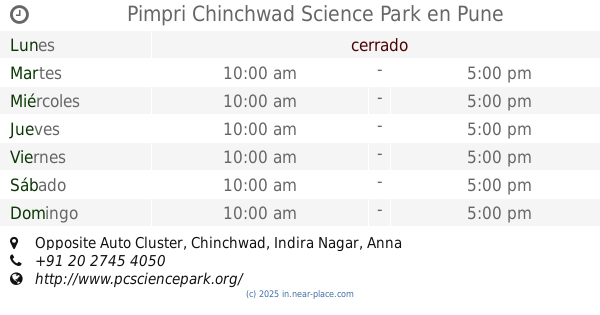cerrado
🕗 horarios
| Lunes | cerrado | |||||
| Martes | - | |||||
| Miércoles | - | |||||
| Jueves | - | |||||
| Viernes | - | |||||
| Sábado | - | |||||
| Domingo | - | |||||
Kakade Park Road, 411033, Pimpri-Chinchwad, Pune, IN India
contactos teléfono: +91 20 2745 4050
sitio web: www.pcsciencepark.org
mapa e indicacionesLatitude: 18.6245013, Longitude: 73.7860936



Rupa Dey
::Awesome place for kids. Those who are interested in physics (specially automobile) must go there. The attached garden is also very interesting. Science students can gain practical knowledge from there.
Arundhati Mishra
::3D show was awesome. Overall its a nice science park. Very good and informative if you are going with kid. My son enjoyed it a lot. Automobile show, planetarium, sound etc were very nice. Price wise its very reasonable also. Must visit place if u have a kid with u.
PARAS PATIL
::The place is good and also it has a park where all the games are made scientifically ! The museum is also good
sonali varavadekar
::Really nice place....really helpful for the students....science explained Behind each and every thing there...just loved it....
ADITYA MHASKE
::The world's first university research park started in the early 1950s near Stanford University. Another early university research park was Research Triangle Park. In 1969, Pierre Laffitte founded the Sophia Antipolis Science Park in France. Laffitte had travelled widely and developed a theory of "cross-fertilisation" where individuals could benefit mutually by the exchange of thoughts in many fields including culture, science and the arts. Science parks are elements of the infrastructure of the global "knowledge economy". They provide locations that foster innovation and the development and commercialisation of technology and where governments, universities and private companies may collaborate. The developers work in fields such as information technology, pharmaceuticals, science and engineering. Science parks may also offer a number of shared resources, such as incubators, programs and collaboration activities, uninterruptible power supply, telecommunications hubs, reception and security, management offices, bank offices, convention center, parking, and internal transportation. Science parks also aim to bring together people who assist the developers of technology to bring their work to commercial fruition, for example, experts in intellectual property law. They can be attractive to university students who may interact with prospective employers and encourage students to remain in the local area. Science parks may be designed to enhance the quality of life of the workers. For example, they might be built with sports facilities, restaurants, crèches or pleasant outdoor areas. Apart from tenants, science parks create jobs for the local community. Science parks differ from high-technology business districts in that they are more organized, planned, and managed. They differ from science centres in that they lead to commercialized products from research. They differ from industrial parks which focus on manufacturing and from business parks which focus on administration. Science parks are found worldwide. They are most common in developed countries. In North America there are over 170 science parks. For example, in the 1980s, North Carolina State University, Raleigh lacked space. New possible sites included the state mental-health property and the Diocese of Raleigh property